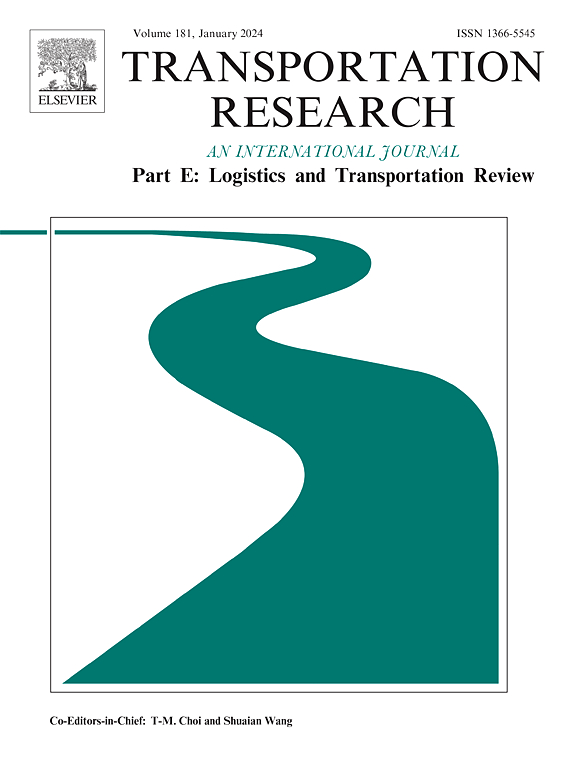Platform-empowered collaboration delivery model for express companies and rural passenger transport operators in rural areas
IF 8.3
1区 工程技术
Q1 ECONOMICS
Transportation Research Part E-Logistics and Transportation Review
Pub Date : 2025-07-21
DOI:10.1016/j.tre.2025.104311
引用次数: 0
Abstract
The rapid surge in e-commerce parcel volume has intensified demands for cost-effective and high-quality express delivery services in rural areas. This study proposes a platform-enabled collaborative delivery model that integrates express companies and rural passenger transport operators to improve last-mile logistics. Our goal is to facilitate efficient collaboration among stakeholders through platform-supported route planning and cost-sharing, with cost savings quickly estimated for decision-making. To assess the benefits of shared transport resources, we adopt a Shapley value-based cooperative game approach to determine cost allocation. This requires solving mixed-integer programming models for all possible alliance structures to compute characteristic functions. A mixed-integer linear programming model is formulated to address the multi-owner collaborative delivery vehicle routing problem with combined passenger and freight transport (MOCDVRP-CPFT), which quantifies delivery costs for each alliance configuration. A tailored solution framework is developed, incorporating batch processing, customer clustering, and an adaptive large neighbourhood search (ALNS) algorithm to generate high-quality solutions across all alliances. Six representative case studies in eastern, central, and western China using real-world data confirm the effectiveness of the proposed model, with the most significant savings observed in the western region. Based on the results, we offer region-specific policy suggestions to facilitate the implementation of CPFT in varying rural contexts. This study highlights the potential of digitally enabled, short-term collaborative alliances as a practical approach to improving rural logistics coordination and delivery efficiency.
面向农村地区快递公司和农村客运经营者的平台化协同配送模式
电子商务包裹量的快速增长加剧了农村地区对经济高效、高质量快递服务的需求。本研究提出了一种整合快递公司和农村客运运营商的平台协同配送模式,以改善最后一公里物流。我们的目标是通过平台支持的路线规划和成本分担,促进利益相关者之间的有效协作,并快速估算成本节约,以供决策。为了评估共享交通资源的效益,我们采用基于Shapley价值的合作博弈方法来确定成本分配。这需要求解所有可能的联盟结构的混合整数规划模型来计算特征函数。针对客货联运的多业主协同配送车辆路径问题,建立了一个混合整数线性规划模型,量化了每个联盟配置的配送成本。开发了一个定制的解决方案框架,结合了批处理、客户聚类和自适应大邻域搜索(ALNS)算法,以生成跨所有联盟的高质量解决方案。中国东部、中部和西部的六个代表性案例研究使用真实数据证实了所提出模型的有效性,其中西部地区的节约效果最为显著。根据研究结果,我们提出了针对不同地区的政策建议,以促进在不同农村环境下实施CPFT。该研究强调了数字化短期合作联盟作为改善农村物流协调和交付效率的实用方法的潜力。
本文章由计算机程序翻译,如有差异,请以英文原文为准。
求助全文
约1分钟内获得全文
求助全文
来源期刊
CiteScore
16.20
自引率
16.00%
发文量
285
审稿时长
62 days
期刊介绍:
Transportation Research Part E: Logistics and Transportation Review is a reputable journal that publishes high-quality articles covering a wide range of topics in the field of logistics and transportation research. The journal welcomes submissions on various subjects, including transport economics, transport infrastructure and investment appraisal, evaluation of public policies related to transportation, empirical and analytical studies of logistics management practices and performance, logistics and operations models, and logistics and supply chain management.
Part E aims to provide informative and well-researched articles that contribute to the understanding and advancement of the field. The content of the journal is complementary to other prestigious journals in transportation research, such as Transportation Research Part A: Policy and Practice, Part B: Methodological, Part C: Emerging Technologies, Part D: Transport and Environment, and Part F: Traffic Psychology and Behaviour. Together, these journals form a comprehensive and cohesive reference for current research in transportation science.

 求助内容:
求助内容: 应助结果提醒方式:
应助结果提醒方式:


